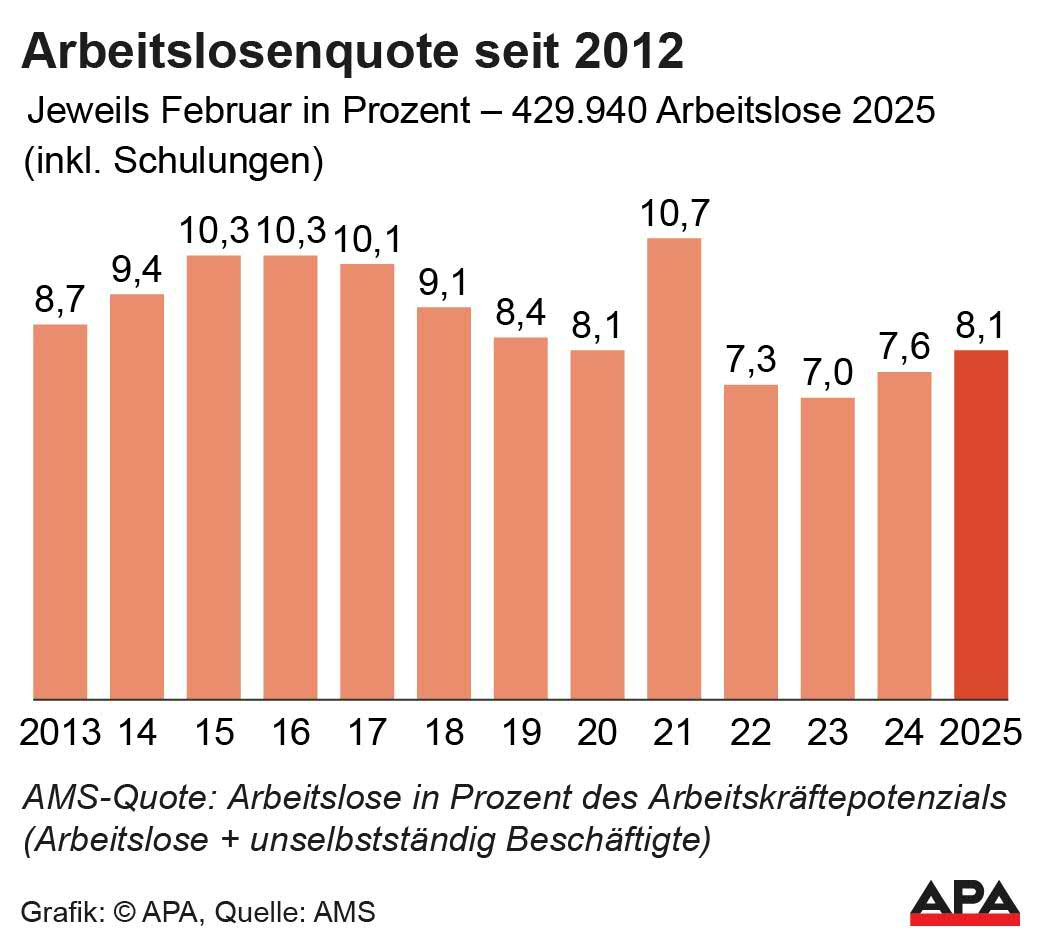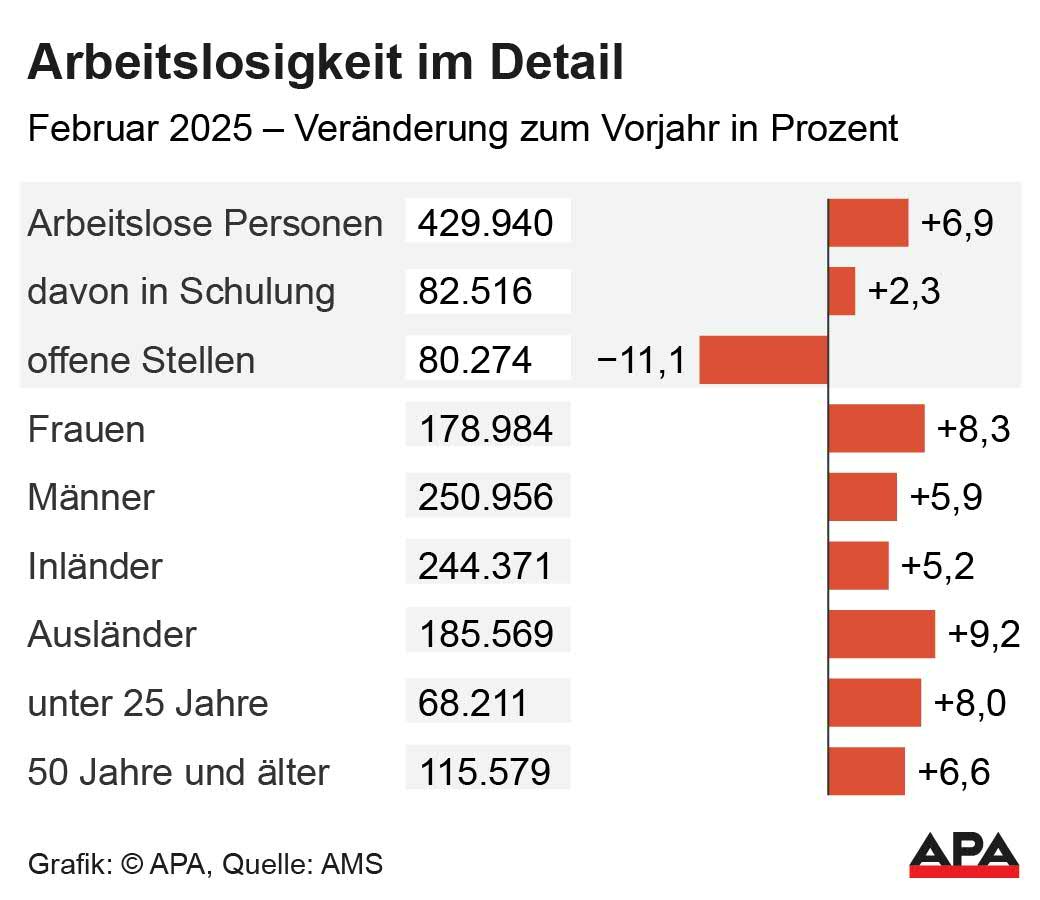Unemployment Rose in February

The weak business development in industry and trade continues to drive up unemployment figures. At the end of February, 429,940 people were registered as unemployed or in training with the Public Employment Service (AMS), of which 347,424 were unemployed and 82,516 were in AMS training programs. Compared to the same month last year, the number of unemployed and training participants increased by 6.9 percent or 27,643 people.
Higher Unemployment Rate
The unemployment rate increased by 0.5 percentage points to 8.1 percent. "It is not an easy start for a new federal government," commented AMS board member Johannes Kopf on the current unemployment figures in a statement. Austria has been in a recession for about 2.5 years, and this is "also clearly shown by the labor market." Kopf positively evaluates the government program of the new turquoise-red-pink coalition. "The new federal government has announced that it will equip the AMS with significantly more budget to combat unemployment. This is an important first step," said the AMS chief.
The recession in Austria is clearly burdening the labor market. Unemployment figures have been rising since April 2023. A noticeable improvement is not yet in sight. The immediately available open positions decreased by 11.1 percent to 80,274 at the end of February compared to the same month last year. The ÖVP Economic Association records all job portals in its job monitor and noted 148,444 open positions. The temporary employment agency Randstad pointed to changing attitudes towards employment in Austria. For the first time in the 22-year history of the Randstad study "Workmonitor," "job security" (79 percent) has a higher priority for employees than "salary" (75 percent).

The largest percentage increase in unemployed people and those in AMS training at the end of February compared to the same month last year was in manufacturing/industry (+14.9 percent) and health and social services (+12.2 percent). The increase was somewhat lower in trade (+8.3 percent), gastronomy and accommodation (+5.7 percent), and transport and warehousing (+5.2 percent). There was a slight increase in unemployment in construction (+2.5 percent) and temporary employment (+0.1 percent).
Upper Austria with the Largest Increase
The highest increase in unemployed and training participants was recorded in Upper Austria (+15.2 percent), followed by Salzburg (+11.2 percent), Tyrol (+8.8 percent), Styria (+7.7 percent), Vorarlberg (+6.3 percent), and Vienna (+5.5 percent). The increase was lower in Lower Austria (+3.6 percent), Carinthia (+3.5 percent), and Burgenland (+2.7 percent). The highest unemployment rate at the end of February was recorded in Vienna at 12.4 percent, followed by Carinthia (9.5 percent), Burgenland (8.4 percent), Styria (7.7 percent), and Lower Austria (7.5 percent). A low unemployment rate was found in Upper Austria (6.4 percent), Vorarlberg (5.7 percent), Salzburg (4.7 percent), and Tyrol (4.4 percent).
The number of unemployed nationals, including training participants, increased by 5.2 percent to around 244,371, and the number of unemployed foreign nationals increased significantly by 9.2 percent to 185,569.

AK President Renate Anderl pointed out in a press release the insolvencies of retailers Kika/Leiner and Palmers as well as the motorcycle manufacturer KTM and the negative impact on the labor market. "This negative trend must be stopped. The fight against youth and women's unemployment must now be a top priority," said Anderl. ÖGB Federal Managing Director Helene Schuberth calls for "rapid employment offensives" that were announced in the government program of the new turquoise-red-pink coalition. The ÖVP Economic Association wishes for the economic location "a comeback of performance": "Tax-free bonuses, favorable overtime, and reliefs for working in old age are essential to stimulate the labor market and counteract the shortage of skilled workers," said Economic Association Secretary General Kurt Egger.
Thousands of Apprentices in Training
According to the Ministry of Labor, 97,424 apprentices are currently being trained in Austrian companies, 28,796 of them in their first year of apprenticeship. Currently, there are more people looking for apprenticeships than there are available positions: 7,891 young people are registered as seeking apprenticeships with the AMS, and the number of open apprenticeship positions amounts to 7,616.

Decline in GDP
The domestic economic performance also declined in the fourth quarter of 2024. According to calculations by Statistics Austria, the Gross Domestic Product (GDP) fell by 0.4 percent in real terms compared to the previous quarter, and the year-on-year decline was 0.5 percent. This presents a gloomy picture, as the Austrian Institute of Economic Research (Wifo) had estimated a decline of 0.2 percent year-on-year in its quick estimate at the end of January.
The location Austria is currently experiencing "the longest phase of weakness since the beginning of the corresponding calculations in 1995," explained Statistics Austria Director General Tobias Thomas in a press release on Monday. Overall, domestic economic performance decreased by 1.2 percent in 2024 compared to the previous year, according to preliminary calculations. "Austria remains in recession, which has now lasted for two years. By the end of 2024, economic performance declined again, although not as sharply as before," said the statistics chief.
In its quick estimate for the fourth quarter at the end of January, Wifo had assumed a GDP decline of 0.2 percent year-on-year and stagnation compared to the previous quarter. For the entire year 2024, the GDP would have shrunk by one percent "based on seasonally and working-day adjusted values."
The domestic economy has been struggling with a downturn since 2023, but according to Statistics Austria, the decline gradually weakened over the past year 2024. In the first quarter of 2024, the decline was still at 1.9 percent, in the second quarter it was -1.4 percent, and in the third quarter -0.8 percent.
Manufacturing and Construction Most Affected
The negative development in the fourth quarter affected almost all economic sectors, with manufacturing (-5.6 percent), construction (-2.5 percent), and gastronomy and accommodation (-2.6 percent) being the most affected. However, there were positive growth rates in the area of public administration, health, and education (+3.5 percent). Looking at the entire year, a similar picture emerges, with only trade showing positive impulses again in the fourth quarter (+0.4 percent).
The economic development in the 4th quarter of 2024 also deteriorated due to the lower investment volume (-2.1 percent) and the decline in exports (-5.0 percent). The decline in investments was mainly due to the decreased construction investments (-3.1 percent). Meanwhile, there was a recovery in consumption, which increased by 1.5 percent compared to the previous year's quarter (private consumption +0.8 percent, public consumption +3.1 percent). Over the entire year, private consumption remained unchanged, while public consumption increased by 1.6 percent.
Nominal employee compensation recorded an increase of 8.5 percent for the entire year 2024. The number of employees changed only slightly (+0.1 percent), while the number of self-employed decreased slightly (-0.2 percent). The hours worked increased by 2.6 percent in the fourth quarter, resulting in a decline of 1.0 percent for the entire year.
(APA/Red)
This article has been automatically translated, read the original article here.





